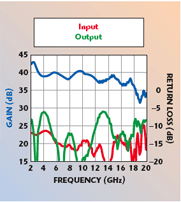
A solid-state driver amplifier has been introduced that operates from 2 to 18 GHz and offers 35 dB of gain and 31.5 dBm of output power at the 1 dB compression point. The model KS6378 SSPA operates from 15 V DC at 2.6 A, and is housed in a 5" × 2.1" × 0.7" package with SMA connectors. With its 2.7 dB typical noise figure, this new amplifier is ideally suited for a driver amplifier for VED amplifiers and higher power solid-state power amplifier applications, as well as in instrumentation, electronic warfare simulation and broadband, high dynamic range receive systems.
The KS6378 broadband amplifier combines the advantages of high frequency MMIC performance and reliability with state-of-the-art packaging to achieve outstanding broadband power amplification at an economical cost. The amplifier takes advantage of commercially available broadband MMICs to achieve moderate power amplification from 2 to 20 GHz. The package includes a copper heat spreader to optimize heat dissipation and enhance reliability. Table 1 lists the KS6378 amplifier’s typical performance. Figure 1 shows its noise figure vs. frequency characteristics, Figure 2 its gain and return loss, and Figure 3 its power output performance.

Design Details
The challenge was to implement the MMICs in a configuration that was lower in cost than traditional microwave integrated circuit (MIC) hybrid circuitry. Hence, a cost-effective, high performance package was developed for MMICs that is compatible with current surface-mount processes and exhibits extremely low parasitic elements. To support the high power dissipation and high frequency performance, the package incorporates a CuW heatspreader with a leadless LTCC ringframe that provides nonresonant perfomance to greater than 20 GHz. This unique package has been labeled the CPM module by CAP Wireless.
The package interconnect is key to its ability to offer high performance. Compared with other MMIC packages that offer leaded interconnects, the CPM module features a leadless interconnect that minimizes parasitic elements. This feature supports the highest frequencies of operation without degrading gain, VSWR or power loss. Additionally, the configuration of the CPM package supports multiple MMICs from various manufacturers.

The CuW heatspreader is designed to absorb some of the stresses due to mismatches of the cofficient of thermal expansion (CTE) of the GaAs MMIC die and the heatsink material (typically Cu), while providing a highly thermal conductive path to remove heat from the die. The LTCC package can be sealed using a low cost epoxy seal for commercial applications, or using a hermetic, solder seal for military applications. By sealing and protecting the MMIC circuit, the remaining circuitry can be processed and handled by normal surface-mount processes, and the entire package does not require hermetic sealing. Significant effort was expended to develop a solder seal ring structure for the hermetic lid attachment that was resonance free to greater than 20 GHz.
The LTCC package is designed to be directly soldered to both the heatsink surface and the substrate. This implementation, while excelling in thermal and electrical characteristics, challenges the mechanical environment due to the potential stress imposed on the mating substrate. Rogers RT/duroid® was chosen as the inter-MMIC substrate for its compatibility with traditional circuit board processing, its high performance, low loss characteristics, and its ability to operate under multiple cycles of compressive and tensile stress imposed by a potential CTE mismatch without failing.

Figure 4 illustrates a typical implementation of a CPM module in a broadband, high thermal conductivity LTCC package. Once the implementation of the MMICs into the LTCC package is successfully completed, the implementation of a multi-chip line up to achieve required specification targets is relatively straightforward.
Conclusion
A broadband solid-state driver amplifier has been introduced that features low noise and high gain over the 2 to 20 GHz frequency range. This new driver amplifier can provide up to 31.5 dBm of output power by utilizing GaAs MMIC technology and state-of-the-art thermal packaging that offers enhanced reliability and consistency at an economical cost.
CAP Wireless Inc.,
Newbury Park, CA
(805) 499-1818,
www.capwireless.com.

